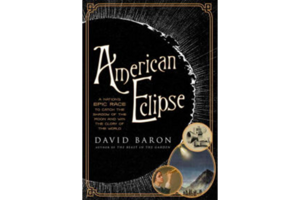'American Eclipse' writer David Baron: 'A total eclipse for me is a spiritual experience'
Baron's book remembers when figures including Thomas Edison and astronomer Maria Mitchell converged on the Rocky Mountain region to observe the 1878 eclipse.

'American Eclipse' is by David Baron.
In the 1870s, "woman astronomer" would have sounded almost as bizarre as "space shuttle." But times were changing fast.
On a late July day in 1878, a Vassar professor of astronomy named Maria Mitchell and a contingent of female students converged on the Rocky Mountain region to observe one of nature's most extraordinary spectacles. Others from the pinnacle of American science were there too, including a young inventor who had more than an ordinary interest in light – Thomas Edison.
Science writer David Baron tells their stories in his new engaging book American Eclipse: A Nation's Epic Race To Catch The Shadow Of The Moon And Win The Glory Of The World.
As thousands of Americans head west to watch another total eclipse on Aug. 21, Baron talks eclipses – the one they saw, the ones he's seen, and where he'll be perched on the big day.
Q: What do eclipses mean to you?
It's hard for me to really say this, but a total eclipse for me is a spiritual experience.
I don' t consider myself spiritual, and I'm not religious in any traditional science. I was a physics major in college, and I've been a science writer since then. I don't believe there is a higher being who's ruling things.
But a total eclipse taps into a feeling like that felt by people who are religious – the grandeur of the universe, and how I am as an individual absolutely nothing. But I'm OK with that because I feel like I'm part of something enormous and grand and beautiful. It's just overpowering.
Q: Do you think people felt different about eclipses in the past when they didn't understand it as well from a scientific perspective?
In the past, there was fear. For a long time, they didn't understand it was the moon blocking the sun or even what the sun was.
You'd have your entire world turned upside down in the space of a couple minutes: The sun goes away, the sky is painted weird colors, the stars are out, and there's this beautiful shimmering wreath around the sun that you've never seen before.
There's fear involved even today. That's what awe is: this mixture of amazement and, in some sense, horror.
Q: Why were American scientists and astronomers of 1878 so eager to see the eclipse in person?
In the mid- to late 19th century, total eclipses went from being spectacles to be afraid of – and to marvel at – to being very useful to science. It was only at that time that scientists were staring to unravel the mysteries of the sun: What is the great ball of fire in the sun made of?
And there were certain studies they could only do during a solar eclipse, when the moon blocked the sun and allowed them to study the edge of the sun, the atmosphere, and corona.
The sun gives off so much energy, but where does it come from? Did it really belong to the sun? Or was it dust or meteors pouring into the sun? One theory was that maybe there's this constant rain of material from space.
Every 18 months, a total solar eclipse occurs somewhere on the planet. They figured out where they could go with a ton of equipment and pray that clouds wouldn't get in the way.
Q: How was the 1878 eclipse important in the long run?
It encouraged the public in the US to get excited about science and start thinking of ourselves as a country that could challenge Europe as a scientific power.
The other effect was to open the doors of science to women, to get the public to start looking at them as working scientists.
Q: Where will you be when the big eclipse hits?
I'll be in Jackson, Wyo., which is an easy drive from where I live in Boulder, Colo.
Jackson is one of the prettiest places in the country, and three years ago, I found a hotel willing to take us. I convinced a dozen family members to join me.
It will be an absolute zoo.
Q: Will you need those special eclipse sunglasses to protect your eyes?
For up to 2 minutes and 40 seconds of the total eclipse, depending on where you are in its path, you do not need eclipse glasses. That's the only time when it's safe to look at the sun with the naked eye. It's jaw-droppingly beautiful.
We plan to be on the top of one of the mountains in the Tetons at 10,000 feet. The goal is not only to look up and marvel at the eclipse but also to look west for the moon's shadow as it races for us at 2,000 miles an hour.
They described this in 1878 and called it a palpable curtain of darkness. They could see distant peaks in the sunlight pop out of sight as the shadow came over them. This is what I want to see.


